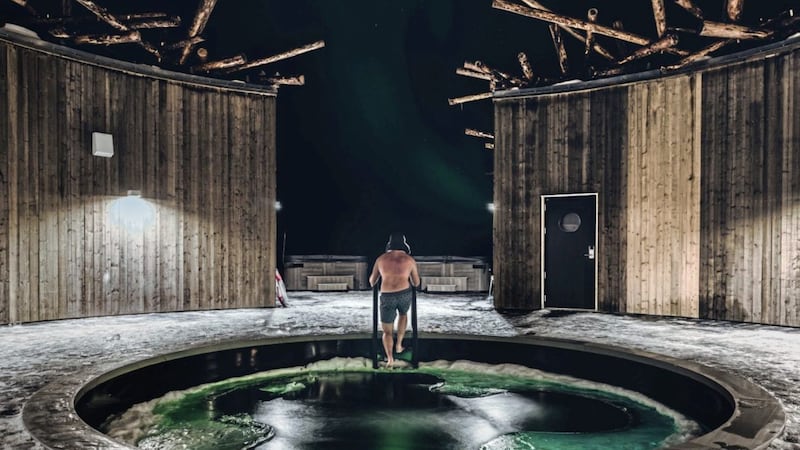FOR as long as I can remember what it feels like to shake and shiver, I've been taught to fear the cold. Always wrap up warm. Don't leave home without a coat. And never, ever go out with wet hair.
Even the fact a cold is called a cold seems a little unfair. Why should a temperature drop get the blame for sneezing and a snotty nose? And since when did the weather become contagious – can you really catch a chill?
A subject of superstitious old wives' tales more fearsome than the bogeyman, we've been conditioned to dread and detest "the cold". There's even a name for extreme cases – frigophobia, where sufferers believe sub-zero conditions could lead to death.
But what if we were to turn the tables and embrace the very thing that scares us?
"There's nothing to be frightened of," assures therapist Nina Medin, as I slowly crunch through ice and slip into a skin-prickling pool of 4C river water – the centrepiece of new highly-hyped, high-end design hotel Arctic Bath.
Clad with logs – like a doughnut sprinkled with hundreds and thousands – the property's circular spa floats or freezes in Swedish Lapland's Lule River – depending on the season. An architectural masterpiece which demands deep pockets, it's destined to grace multiple Instagram feeds. But a commitment to it's cultural context makes 2020's most exciting hotel opening much more than a pretty face.
:: The not-so-chilling story
As synonymous as the sauna is with Finnish culture, taking a cold bath is at the core of Swedish wellbeing. The pair go together, in fact, like ying and yang: diametrically opposing but complementary in so many ways.
Based on the teachings of 19th century Bavarian priest Sebastian Kneipp, who cured his tuberculosis by taking regular river dips, there's a theory that switching between hot and cold can boost your immune system. Contrary to popular belief, the cold can be good for your health.
The idea to create a hotel dedicated to the wellness tradition started with a conversation 10 years ago over dinner at neighbouring Treehotel, an equally striking and fantastical project featuring cabins suspended between pine trees.
Bertil Harstrom, the architect responsible for the outrageous Bird's Nest (a tangle of twigs with beds), had ambitions to build a cold bath in an imaginative and innovative style. "He spent years searching for the right location," says AnnKathrin Lundqvist, an interior designer and one of Arctic bath's co-founders. "Watching how the Lule River flowed and how the ice formed and melted."
:: Developing a spa addiction
Sauna etiquette is second nature to Scandinavians, but for many of us, it's a mystery. A SaunaGus spa ritual is the perfect introduction. Moving between Arctic Bath's wood pellet-fuelled saunas, Nina throws essential oils mixed with water onto hot rocks and circulates the steam by swinging a towel above her head.
I'm invited to breathe and meditate before heading outside to the cold bath, a circuit which becomes addictive after a couple of days. Starting with a tentative toe wriggle, I soon progress to full immersion, tilting my head back and gazing at the stars. Eventually, I even manage a short swim.
The feeling? Like a million electrodes pulsing through my body; my mind cleared of all thoughts bar one. As Nina explains: "When your body kicks into survival mode, that's when you really see results."
At present, the spa has only one treatment room (although there are plans to build a separate building in the next few years), with a menu of facials and massages curated by eco and vegan Swedish skincare brand Kerstin Florian.
:: Sleeping with dreamy designs
From bespoke, pollutant-free, organic cotton swimsuits (every guest gets one; you can't wear your own), to furnishings supplied by classic Swedish brands, every design detail of the property has been finessed with meticulous care.
There are 12 rooms, divided between water and land – all with endlessly pleasing, spine-tingling views. On land, larger split-level cabins can sleep up to five, with spiral staircases leading to a mezzanine. Warm honey-toned lighting and use of natural materials are as comforting as a cuddle, while a sedum roof signifies a change in seasons with an array of budding flowers.
Suited to two, smaller water rooms also have year-round appeal: north-facing windows are perfect for aurora watching, while in summer, guests are invited to swim or kayak from their private deck.
:: Dining the sustainable way
Sticking to locally sourced food is a challenge this far north – especially in winter. But Kristoffer Astrom, who's been lauded as Scandinavia's only gourmet Sami chef, and his kitchen partner, Maarten De Wilde, have committed to using whatever Mother Nature gives them.
Their creations are showcased in nightly five-course menus (included in the room rate): six-day cured trout rests on a bubbly pillow of celeriac puree and lingonberries glisten on a surprisingly tasty reindeer blood pancake. Squeamish for some, but this is sustainability; typical of Sami culture, nothing goes to waste.
:: Putting the property in context
A 10-minute walk away, 600-person village Harads has points of interest: a dusty museum filled with antique looms and rat traps, a church with an eyeball painted above the altar, and an Iranian pizzeria where reviews swing like a pendulum from dreadful to excellent. Learn about community quirks from local guide Thorbjorn Enberg, who'll invite you into his home for Swedish fika (coffee – Swedes drink an eye-popping average of eight cups a day – and cake).
An hour's drive away, Pite River's Storforsen rapids tell the story of this region's "timmerflottning" industry, where logs were floated from forests to sawmills. (It's a slice of history that inspired Arctic Bath's design.) A walkway hugs the raging water, and on frosty days evaporation dresses trees with crystal tips.
But perhaps the most memorable activity on offer at Arctic Bath is a morning spent with Sami reindeer herder Anna Kuhmunen in Jokkmokk. After feeding her herd with fuzzy, soft bundles of lichen, we sit around a fire in her lavvu listening to folkloric tales and learning about the modern day struggles of the original inhabitants of "Sapmiland".
"I will die to protect my reindeer, until my last breath," insists Anna, tearing a piece of Sami flatbread gahkku to share. "They keep my people alive."
Fluctuating temperatures and an uncharacteristically warm January have created problems for her herd, whose main food source is currently locked beneath a layer of ice on the forest floor. "We hope for more snow soon."
Eyes bluer than glacial pools and with cheeks rubbed crimson by the wind, Anna is at home in the cold. Having quelled my fear of low temperatures, finding new strength in sustaining shivers, I think I've become a fan of it too.
FACT FILE
:: For more Arctic Bath details and booking visit arcticbath.se
:: Information on Swedish Lapland can be found at swedishlapland.com
:: See visitsweden.com for travel and accommodation ideas and details throughout Sweden








